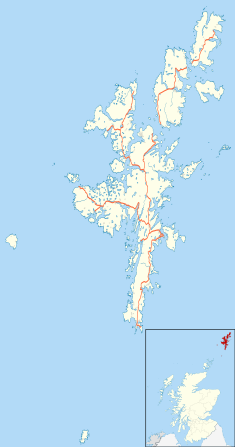Belmont House, Shetland
| Belmont House | |
|---|---|
 Belmont House | |
| Coordinates | 60°41′15″N 0°58′02″W / 60.6876°N 0.9673°WCoordinates: 60°41′15″N 0°58′02″W / 60.6876°N 0.9673°W |
Listed Building – Category A | |
| Designated | 13 August 1971 |
| Reference no. | LB17474 |
| Criteria | Work of Art, Architectural |
| Designated | 31 March 2003 |
| Reference no. | GDL00054 |
 Location in the Shetland Islands | |
Belmont House is a Georgian country house on the island of Unst, the most northerly of the Shetland Islands, Scotland. It was constructed in 1775 by Shetland landowner Thomas Mouat of Garth, and has been described as "possibly the most ambitious, least-altered classical mansion in the Northern Isles."[1] The house was restored from a derelict state between 1996 and 2010 by the Belmont Trust. The house is now used as a self catering holiday house and venue for events. It is protected as a category A listed building,[2] and the grounds are included on the Inventory of Gardens and Designed Landscapes in Scotland, the national listing of significant gardens.[1]
For holidays and events[]
Belmont House is used by visitors and locals as a self-catering venue for holidays, weddings and other events and is managed by the Belmont Trust as a not-for-profit enterprise, with any surplus funds reinvested in the house and community.
The house was restored from 1996 to 2010 to its original Georgian elegance but with the addition of modern amenities. It is furnished with Georgian furniture and comfortable new beds and settees. The property can sleep up to 12 people. www.belmontunst.co.uk
Gardens[]
Walled gardens are laid out to the south of the house. These have been restored by The Belmont Trust with walls restored and trees and shrubs planted to form sheltered spaces to sit and enjoy the views over Bluemull sound to the south. The gardens are open to the public.
History[]
Belmont was built in 1775, with the farm square to the rear complete by 1790; together they form “miniature Palladian classical groups with flanking pavilion wings” (ref Buildings of the Land: Scotland's farms 1750–2000, Miles Glendinning and Susanna Martins, ed Piers Dixon; RCAHMS 2008). Surrounding enclosures including garden grounds form a regular layout running down to the sea. The house and adjacent farm square are designated category A, and the grounds are included on the Inventory of Gardens and Designed Landscapes in Scotland.
The house was built for Thomas Mouat, whose father William was laird of the Garth estate in Shetland. Thomas visited Lothian, around Edinburgh, to gather ideas on contemporary architecture, and may have been influenced by Hopetoun House.[1]
In the early 19th century the east wing was added to the house (now demolished), but otherwise it has remained unaltered. The Mouat family continued to occupy the house until the mid 20th century. It was then sold, and became derelict.[1] In 1996 the Belmont Trust was established to oversee the restoration of the house. Over the following 15 years works were carried out, largely by local craftsmen, to bring the building back into use. It is now operated by the trust as self-catering accommodation and as a venue for hire.[3] The original interiors are described by Historic Scotland as "a particularly remarkable survival."[2]
References[]
- ^ a b c d Historic Environment Scotland. "BELMONT HOUSE (GDL00054)". Retrieved 11 January 2019.
- ^ a b Historic Environment Scotland. "BELMONT, BELMONT HOUSE... (Category A Listed Building) (LB17474)". Retrieved 11 January 2019.
- ^ "About the Belmont Trust". Belmont Trust. Archived from the original on 9 August 2011. Retrieved 25 August 2011.
External links[]
![]() Media related to Belmont House, Shetland Islands at Wikimedia Commons
Media related to Belmont House, Shetland Islands at Wikimedia Commons
- Category A listed buildings in Shetland
- Listed houses in Scotland
- Inventory of Gardens and Designed Landscapes
- Houses completed in 1775
- Country houses in Shetland
- Unst
